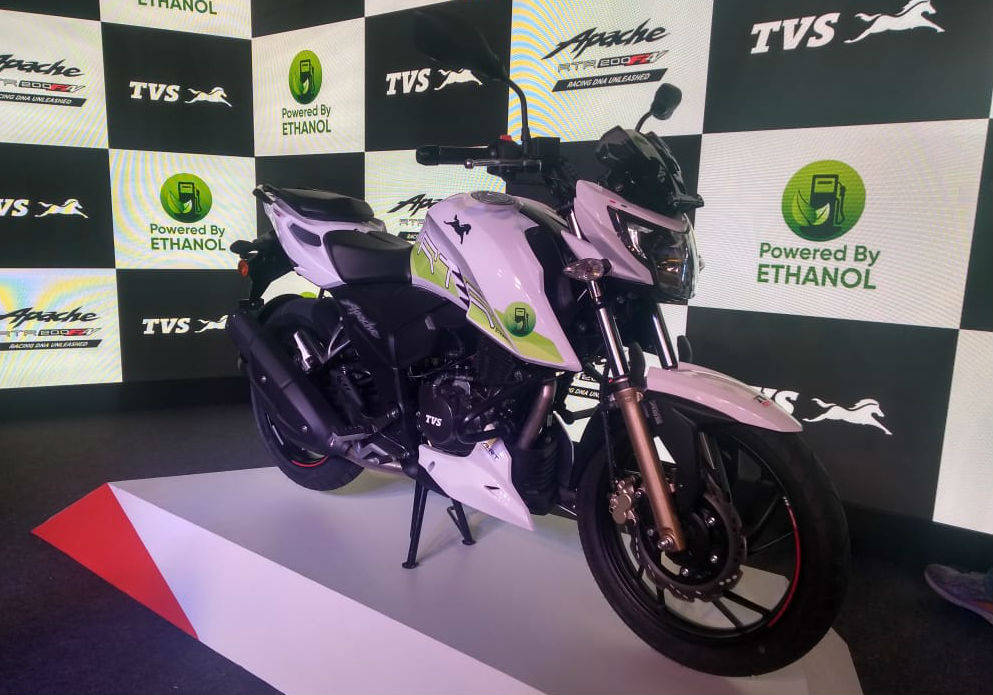Ethanol vs Petrol-powered Motorcycles: How Different Are They?
Published On July 15, 2019 19:17 IST
By Praveen M. for TVS Apache RTR 200 Fi E100
- 3023 Views
Is ethanol really beneficial to both the end-user and the environment compared to petrol-powered vehicles? We take a closer look

TVS recently launched the country’s first 100 per cent ethanol-powered motorcycle, the Apache RTR 200 Fi E100. So are you wondering how different an ethanol-powered vehicle is when compared to a petrol-powered one, especially in terms of running costs and emissions? Well, let us help you out:
Ethanol is made from renewable resources while petrol is not

Ethanol is produced by the fermentation of glucose derived from sugar (sugar cane), starch (corn-based plants) and cellulose (wood and forest products). Countries such as Brazil are well known for kickstarting the widespread use of ethanol to power automobiles. In fact, it is the largest exporter of ethanol in the world. Since ethanol is produced from plant-based resources, there’s a potential to manufacture it in India itself.

On the other hand, petrol is made from crude oil that is obtained from deep under the surface. Crude oil is largely restricted to its availability in certain regions, and India isn’t exactly known to be an oil-rich country. Moreover, global oil reserves are depleting and this has led to various governments pushing the use of vehicles that run on alternative sources of fuel.
But is ethanol more efficient than petrol?

Technically speaking, it isn’t. A litre of ethanol has around 34per cent less energy compared to the same quantity of petrol. So this results in more fuel consumption compared to a petrol-powered counterpart. But on the flipside, ethanol has a higher octane rating. If the octane rating is greater, then the engine can run at higher compression. However, cost-effective, small-capacity motorcycles cannot achieve a higher compression ratio without compromising on reliability. That said, running a motorcycle purely on ethanol will have monetary benefits only if the price of ethanol is considerably lower than the price of petrol. Currently, with petrol prices hovering around the Rs 70 mark, ethanol should cost about Rs 50 to outweigh its inherently low calorific value (amount of energy contained).
But is it available in India?
The government is yet to create a proper supply network for pure ethanol, and the necessary permissions for ethanol distribution are being discussed. Even though the Apache RTR 200 Fi E100 is only available in Maharashtra, Uttar Pradesh and Karnataka for now, there isn’t any official supply of ethanol yet.
Does it run cleaner than petrol?

In many ways, yes. However, an engine running on ethanol needs to have its internal components designed specifically for this purpose. TVS has used twin-port twin-spray fuel injection technology which has been tuned to run on pure ethanol in the Apache. The Hosur-based brand claims that it results in 50 per cent less benzene and butadiene emissions. Additionally, when compared to petrol-powered counterparts, nitrogen, particulate matter, sulphur dioxide and carbon monoxide emissions are reduced as well.

But while the particulate emissions are reduced considerably, burning ethanol still emits a lot of harmful ozone as per a study done by Stanford University. Now, ozone is highly corrosive in nature, and this can lead to various health complications as well. Ethanol burning also produces formaldehyde and acetaldehyde, which are cancer-causing compounds. In essence, using ethanol comes with its own set of drawbacks.
